A Turkish Airlines flight was forced to make an emergency landing at John F. Kennedy International Airport after the pilot suddenly fainted and died during the journey. The flight, designated TK204, had departed from Seattle shortly after 7 PM on Tuesday, bound for Istanbul, but made an unexpected detour, landing in New York at 5:57 AM Wednesday.
According to a statement from Turkish Airlines spokesman Yahya Üstün on X (formerly Twitter), the pilot, identified as İlçehin Pehlivan, 59, collapsed during the flight, which was roughly eight hours into its route and passing over Baffin Island in northern Canada when the emergency landing was initiated.
Despite immediate attempts by the crew to administer first aid, the efforts were unsuccessful. The decision to divert the aircraft was made by another pilot and the co-pilot as they recognized the seriousness of the situation. Unfortunately, Pehlivan was pronounced dead before the plane could land.
Turkish Airlines confirmed that Pehlivan had been with the company since 2007 and had undergone regular medical checkups, with the most recent evaluation occurring in March, which revealed no health issues.
In a heartfelt message, Üstün expressed condolences, stating, “As the Turkish Airlines family, we wish God’s mercy upon our captain and patience to his grieving family, all his colleagues, and loved ones.”
The incident adds to a worrying trend of medical emergencies involving pilots in the cockpit. In June 2022, a pilot on a Piper aircraft did not realize his co-pilot had suffered a fatal cardiac episode until after landing. Earlier this year, an easyJet co-pilot fainted mid-flight, but the plane landed safely, and the pilot received medical attention upon arrival in Lisbon.
As the aviation community reflects on this tragic event, it raises important questions about pilot health and emergency protocols in the skies.
The loss of Captain İlçehin Pehlivan serves as a somber reminder of the risks faced by those in the aviation industry and the vital importance of medical preparedness in ensuring the safety of all onboard.











